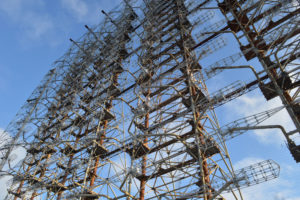What Surgical Errors Teach Us About Nuclear Policy
In the persistence of disastrous medical mistakes, an ER doctor sees a dire warning about human fallibility. Image: Adobe
Image: Adobe
Editor’s note: The following story is co-published with Matt Bivens’ Substack newsletter, The 100 Days.
There is something in medicine we worry about a lot called “a Never Event.” This is an error so terrible we hope it will never be made.
The classic example would be accidentally taking the wrong patient to the OR for someone else’s surgery. Or, a similar example, you’ve got the correct patient but still end up doing the wrong surgery — replacing the wrong hip, or biopsying the wrong kidney, or thinking it’s a tubal ligation when it’s actually supposed to be an appendectomy.
These sorts of errors are incredibly rare. It’s a 1-in-100,000 event.
But we do millions of surgeries in this country. And so it is that about 100 of these awful errors are reported every year (!) across the United States.
Consider “Joan Morris”, age 67, who was admitted for evaluation and treatment of a brain aneurysm. She was resting after a procedure when she was abruptly taken off by mistake — over her own protests! — to have invasive cardiac testing followed by placement of a pacemaker / defibrillator.
A root cause analysis described in Annals of Internal Medicine found 17 separate errors had to happen for “Joan Morris” to get the cardiac procedure meant for “Jane Morrison.” The authors in Annals note:
This event shares many characteristics with other well-known and exhaustively researched calamities, such as the Challenger [space shuttle] disaster, the Chernobyl nuclear reactor explosion, and the Bhopal chemical factory catastrophe … The errors of many individuals (“active errors”) converge and interact with system weaknesses.
Hmm! We will circle back to that.
Case reports of Never Events abound on the medical database PubMed. You can wince reading about an inadvertent spinal injection of the safe anti-nausea medication ondansetron — no harm caused — or gasp in horror about the six-month-old who barely survived receiving a massive transfusion of ABO-incompatible blood; the 9 cm necrotic mass in a patient’s abdomen that turned out to be a 20-year-old bunch of gauze left behind after a remote surgery; and the NICU snafu where a mom ended up breast-feeding the wrong baby.
As I was preparing this article, I saw a patient in the ED with a recurrent right hip dislocation. We planned procedural sedation with propofol. I knew it’d be challenging so I got two other physicians to help, plus nurses, techs, all crowded in a small room. I took up position on the left side for the time out (because nurses were busy on the right with the IV), confirmed we were reducing a dislocated hip, and patted her on the left knee. The patient and everyone else in the room immediately noted it was a right hip dislocation. We all laughed and I moved over to the correct side.
A non-event like this happens almost every day in my experience. And then occasionally, like clockwork, it’s not a near miss, but a direct hit of a disaster.
It turns out that there’s no error that won’t occur simply because “it would be too unthinkably horrible.”
I work full-time and also moonlight a lot. In the past few years I’ve worked at four hospital emergency departments and one urgent care. I also have friends and colleagues at hospitals throughout the northeast. From what I see and hear, the Never Events never stop.
A few that I’m personally aware of from recent years: An EKG showing a large heart attack (a STEMI) missed at triage — somehow just wasn’t looked at! A chest tube placed on the wrong side, in part because a radiology tech flipped the chest X-ray image. A condom catheter (which goes over the penis of a bed-bound patient just like a condom, to collect a urine sample), hooked up to wall suction by mistake, which was sort of exciting. A wrong-site breast surgery. A wire used to place a peripherally inserted central catheter (PICC) line that got accidentally left behind after the procedure, so that it then migrated up an arm vein to the patient’s head. I could go on.
One possible take home message is that we have to try harder to prevent such things, to which I’ll say: Sure! Agreed. Let’s work on it.
Another is that the term “Never Event” is itself a judgy misnomer, because the one thing that’s certain about such events is that they happen. It turns out that there’s no error that won’t occur simply because “it would be too unthinkably horrible.”
Civilization-Ending Never Events
There are lots of threats out there to public health: gun violence, the substance abuse crises, pandemics, obesity. There are even a few that threaten extinction of the entire human species: runaway climate change, a kill-the-dinosaurs level asteroid strike, apocalyptic artificial intelligence developments, and so on.
All of those public health dangers deserve our attention. But I would humbly submit that there is no threat to public health more immediate — and more easily fixable — than the danger of accidental or intentional nuclear war.
There are only two things to know.
One is that America’s nuclear weapons — as well as those in Russia, and most likely in the other seven nuclear-armed countries (China, France, Great Britain, India, Pakistan, North Korea and Israel) — remain poised for launch within minutes, under so-called hair-trigger alert policies.
Both George W. Bush and Barack Obama have publicly spoken out against the policy of launching missiles after just minutes of a panicky Pentagon briefing. The practice of keeping missiles on that kind of hair-trigger alert has been called “absolutely insane” by a former CIA director; “absurd” by a former NSA director; and “an existential threat to the very survival of the United States” by a former head of all U.S. Strategic Nuclear Forces. Another former head of all U.S. Strategic Nuclear Forces has asked Americans to just pray really hard to God we take the weapons off of hair-trigger. Former U.S. secretaries of defense and state have called for total global nuclear disarmament. That’s right, people as mainstream and as plugged in as Cabinet secretaries have recognized that nuclear war is a “Never Event” just waiting to happen.
The other thing to know is that use of even a tiny portion of the world’s nuclear weapons — anywhere in the world — has the potential to end civilization.
That’s right. It doesn’t even have to involve America. A wee little baby war — like a squabble between India and Pakistan halfway around the globe, and that involves less than 1% of world nuclear weapons arsenals — could erase all global warming we’re so worried about, careen us back toward a new Ice Age-level global cooling, and crash planet-wide agriculture. We could see the collapse of all food supplies and of global civilization itself.
In fact, a landmark study published last year found that such a war — 7,000 miles away from the United States — would over the following couple of years cause some 200 million Americans to starve to death. That’s nearly two out of every three Americans, dying horribly, because some hotheads in India and Pakistan have a fight that is essentially all over in about a half-hour.
Those are the only two things one needs to know: Weapons in multiple nations are poised for launch within minutes; they could not only kill millions in an afternoon, but could also kill hundreds of millions, even billions, in coming months and years by crashing the climate and the food supplies.
You may say: Well, we must simply never use these weapons — not even by accident!
And I will reply: Yes! Let’s also never put a pacemaker into the wrong person. Let’s just not!
Even a tiny portion of the world’s nuclear weapons — anywhere in the world — has the potential to end civilization.
Why do irresponsible U.S. nuclear weapons policies persist, even after Democrat and Republican presidents, Cabinet secretaries, CIA directors, NSA directors, and 4-star generals all warn us they are wildly reckless and unnecessary?
In my experience, working with advocacy groups like Physicians for Social Responsibility and International Physicians for the Prevention of Nuclear War, it is because ordinary people prefer not to talk about it, or think about it. I have more than once had a member of Congress tell me or a colleague they absolutely agree this needs addressed — but then they immediately add that they are not hearing from voters or constituents about this, and so for now must stay laser-focused on [day’s hot-button issue].
These mindlessly dangerous practices exist because we haven’t challenged them. Yes, the International Red Cross and the American Medical Association have begged the world to stand down and disassemble thousands of nuclear weapons. Yes, more than 100 medical journals (including the Lancet, the the New England Journal of Medicine, and JAMA) recently united to simultaneously publish the same, identical editorial — an unprecedented event! — that called on the nuclear weapons states “to eliminate their nuclear arsenals before they eliminate us.” And yes, a United Nations treaty to ban nuclear weapons as illegal and immoral came into force in 2021 (even though Washington and Moscow are among those ignoring it).
But the Red Cross, the AMA, the medical journals, the Pope, the outspoken former national security officials — all of their warnings continue to be ignored by the media, the public, and the governments.
Apparently, none of us truly believes a nuclear catastrophe will happen.
Then again, who among us three years ago truly believed we would ever be hiding in our homes from a respiratory virus? What surgeon ever truly believes they might one day cut off the wrong leg?
Your support matters…Independent journalism is under threat and overshadowed by heavily funded mainstream media.
You can help level the playing field. Become a member.
Your tax-deductible contribution keeps us digging beneath the headlines to give you thought-provoking, investigative reporting and analysis that unearths what's really happening- without compromise.
Give today to support our courageous, independent journalists.






You need to be a supporter to comment.
There are currently no responses to this article.
Be the first to respond.